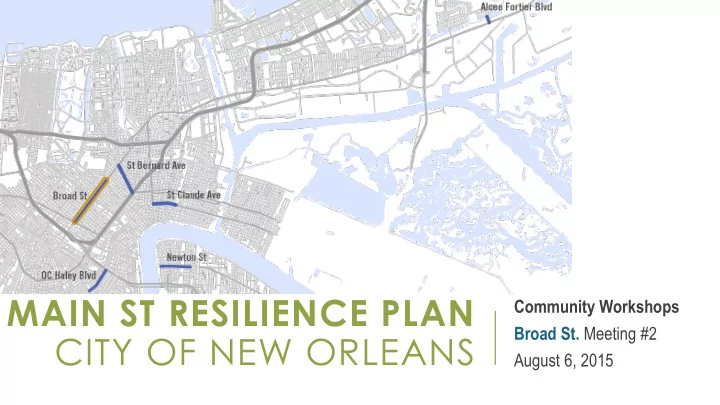

MAIN ST RESILIENCE PLAN Community Workshops Broad St. Meeting #2 CITY OF NEW ORLEANS August 6, 2015
AGENDA • Welcome & Introductions • Project Overview • Vulnerability Assessment Preliminary Findings • Shocks & Stresses • Infrastructure • Buildings • People • Discussion on Resiliency Strategies 2
Goals PROJECT OVERVIEW Schedule Community Engagement
PROJECT GOALS City Planning Commission 1. Developed a shared definition of resilient commercial corridors for New Orleans 2. Create a measurable and actionable methodology for assessing the resilience of commercial corridors or Metro-So Source, urce, llc llc Main Streets. 3. Apply methodology to 6 corridors (5 State-designated Main Streets), in the city and develop individualized recommendations for each to address resiliency gaps 4. Develop how-to guides for businesses for improving resiliency as applied to business operations and for businesses/property-owners for improving building resiliency 4
OVERVIEW OF PLANNING PROCESS • Defining Resilience for Main Streets March / April • Review Previous Efforts Initialization PAC Meeting #1 • Develop standardized assessment PAC Meeting #2 • Data collection (primary) May / June Assessment • Business occupant survey Corridor workshops 1 Business workshops • Commercial and residential market analysis PAC Meeting #3 July / August • Resilience gap analysis Analysis & • Infrastructure improvements and revitalization strategies Corridor workshops 2 Recommendations PAC Meeting #4 Community meetings • Technical guides: business operations & building hardening August / September • Draft and final plan; public presentations Final Plan Public presentations 5
Residential and Commercial Market WHAT WE’VE LEARNED Infrastructure / Built Environment Risk and Other Resilience Elements
ASSESSING A RESILIENT COMMERCIAL CORRIDOR • How vulnerable are corridor facilities and users to shock events • Does the corridor facilitate economic prosperity that can withstand times of stress? • Do corridor businesses have access, availability, and the capacity to engage resources needed to weather shocks & stresses? • Are adequate social networks in place to support corridor businesses during shocks and stresses? 7
ASSESSMENT: KEY POINTS 8
INFRASTRUCTURE & SHOCK EVENTS • Significant portion of corridor in Flood Zone • High historic occurrence of flood claims 9
CORRIDOR ELEVATION 10
BUILDINGS & SHOCK EVENTS • High proportion of: • Strengths • Buildings on grade (77%) • Relatively low number of buildings in below average or worse condition (24%) • Unprotected windows & doors (51%) • Model predicted flooding is minimal (0.7 • MEP not elevated (52%) ft average) • Buildings with appendages (75%) Max Predicted flood depth (ft above manhole rim; 10 year storm) 0.7 Claims per acre of 0.25 mi. buffer 3.67 77.0% Foundation on grade 51.0% Unprotected windows or doors 24.0% In 'below average' or worse condition 52.0% MEP not elevated 75.0% With appendages 43.2% Ground Level Openings >40% of façade 11
CORRIDOR PROFILE: AFFORDABILITY • Median home values are somewhat higher, but median rent is lower Median Home Value Median Rent $250,000 $800 $200,000 $197,727 $765 $750 $183,700 $150,000 $100,000 $700 $706 $50,000 $- $650 Median Home Value Median Rent Broad 1/4 Mile New Orleans Broad 1/4 Mile New Orleans 12
CORRIDOR PROFILE: AFFORDABILITY • More people rent near Broad, and rent is a higher percentage of household income than the rest of the city Rent as Percentage of Income Own vs. Rent Homes 40.0% 35.0% 35.0% % Own 30.0% 31% % Rent 69% 25.0% 24.7% 20.0% % Own 15.0% 47% % Rent 10.0% 53% 5.0% 0.0% Broad 1/4 Mile New Orleans % Rent % Own 13
HOUSING TRENDS: 2009 HOME SALES Source: New Orleans MLS, GCR Analysis 14
HOUSING TRENDS: 2014 HOME SALES Source: New Orleans MLS, GCR Analysis 15
MARKET ASSESSMENT Raw SUPPLY and DEMAND indicators suggest that there is: • High unmet demand for: • General merchandise store (dollar store, City Target): $26.1 million leakage • Automobile dealer: $22.3 million leakage • Gasoline station: $10.6 million leakage • Modest demand for: • Small grocery store: $5.7 million leakage • Small electronics/appliance store: $3.9 million leakage Source: Esri and Dun & Bradstreet, 2015, GCR Analysis . 16
DISCUSSION: IMPROVING RESILIENCE
STRATEGIES • Broad is a diverse corridor and may be best viewed as a collection of unique segments • Focus on characteristics of each section • Identify zoning or other regulatory changes that would encourage development that matches the desired character of individual segments • Allow more intense/dense development at key nodes • Consider development of more refined design and development guidelines • Consider policies to allow development on grade (with appropriate floodproofing) • Develop, improve and maintain public gathering spaces to encourage neighborhood cohesion, identity 18
STRATEGIES • Stakeholder coordination • Improve coordination among businesses • Identify stakeholder groups to act as corridor champions • Identify opportunities for maintaining affordability • Access: • Identify nodes for focused pedestrian facility improvements to link corridor to surrounding neighbhorhoods • Consider adjustments to transit routes, stops & transfers 19
Dwight Norton – GCR THANK YOU dnorton@gcrincorporated.com Judith Dangerfield – Metro Source judithdangerfield@metro-source.com 20
Recommend
More recommend